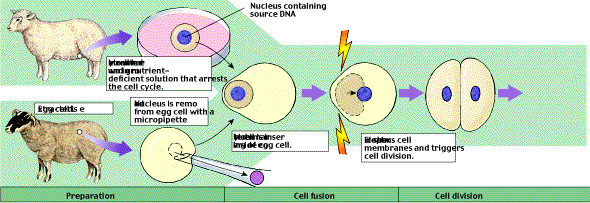Cloning
The difficulty in using transgenic animals to improve livestock is in getting enough of them. Breeding produces offspring only slowly, and recombination acts to undo the painstaking work of the genetic engineer. Ideally, one would like to “Xerox” many exact genetic copies of the transgenic strainbut until 1997 it was commonly accepted that adult animals can’t be cloned. Now the holy grail of agricultural genetic engineers seems within reach. In 1997, scientists announced the first successful cloning of differentiated vertebrate tissue, a lamb grown from a cell taken from an adult sheep. This startling result promises to revolutionize agricultural science.
Spemann’s “Fantastical Experiment”
The idea of cloning animals was first suggested in 1938 by German embryologist Hans Spemann (called the “father of modern embryology”) who proposed what he called a “fantastical experiment”: remove the nucleus from an egg cell, and put in its place a nucleus from another cell.
It was 14 years before technology advanced far enough for anyone to take up Spemann’s challenge. In 1952, two American scientists, Robert Briggs and T. J. King used very fine pipettes to suck the nucleus from a frog egg (frog eggs are unusually large, making the experiment feasible) and transfer a nucleus sucked from a body cell of an adult frog into its place. The experiment did not work when done this way, but partial success was achieved 18 years later by the British developmental biologist John Gurdon, who in 1970 inserted nuclei from advanced frog embryos rather than adult tissue. The frog eggs developed into tadpoles, but died before becoming adults. The Path to Success
For 14 years, nuclear transplant experiments were attempted without success. Technology continued to advance however, until finally in 1984, Steen Willadsen, a Danish embryologist working in Texas, succeeded in cloning a sheep using a nucleus from a cell of an early embryo. This exciting result was soon replicated by others in a host of other organisms, including cattle, pigs, and monkeys.
Only early embryo cells seemed to work, however. Researchers became convinced that animal embryo cells become irreversibly “committed” after the first few cell divisions. After that, nuclei from differentiated animal cells cannot be used to clone entire organisms.
We now know this conclusion to have been unwarranted. The key advance for unraveling this puzzle was made in Scotland by geneticist Keith Campbell, a specialist in studying the cell cycle of agricultural animals. By the early 1990s, knowledge of how the cell cycle is controlled, advanced by cancer research, had led to an understanding that cells don’t divide until conditions are appropriate. Just as a washing machine checks that the water has completely emptied before initiating the spin cycle, so the cell checks that everything needed is on hand before initiating cell division. Campbell reasoned “Maybe the egg and the donated nucleus need to be at the same stage in the cell cycle.”
This proved to be a key insight. In 1994 researcher Neil First, and in 1995 Campbell himself working with reproductive biologist Ian Wilmut, succeeded in cloning farm animals from advanced embryos by first starving the cells, so that they paused at the beginning of the cell cycle at the G1 checkpoint. Two starved cells are thus synchronized at the same point in the cell cycle.
 Figure 23. Wilmut’s animal cloning experiment. Wilmut combined a nucleus from a mammary cell and an egg cell (with its nucleus removed) to successfully clone a sheep.
Figure 23. Wilmut’s animal cloning experiment. Wilmut combined a nucleus from a mammary cell and an egg cell (with its nucleus removed) to successfully clone a sheep.